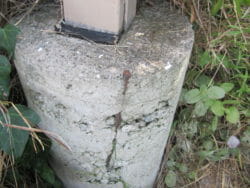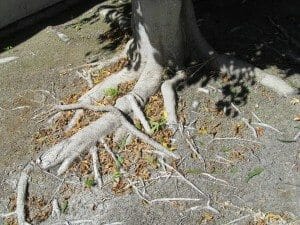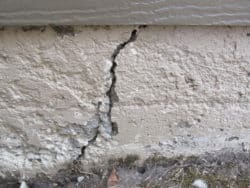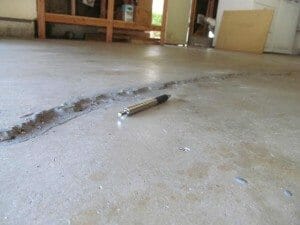Rock Pockets In Foundations and Basement Walls
Home » Structural » Foundation »

When contractors are pouring concrete for the foundation walls they use forms to pour the concrete into. Once the concrete has set-up and gained strength, they strip the forms away where you can then clealy see the concrete.
Occasionally you will see “rock pockets” where there is exposed rock, called aggregate by concrete contractors. When a buyer or home owner sees this, they will often worry that the foundation is defective and not structurally sound; possibly thinking that they’re facing a serious problem. The first question may be what caused this to happen and why didn’t the contractor fix it.
Causes
Rock pockets may be caused by a number of things, some examples:
- If the concrete is too stiff or dry when placed in the forms, then rock pockets may occur; possibly there was insufficient water in the mix and when placed in the forms it was not properly vibrated.
- If the concrete was placed in forms and was too wet (too much water was added) then if overly vibrated, the paste (the cement, sand and fines in the concrete) may have ran out of holes or gaps in the forms leaving an area of exposed aggregate.
- If the concrete was not well mixed in the concrete truck and then placed in the forms or properly vibrated, then it is not unusual to have rock pockets because of segregation or insufficient consolidation.
We might think of these rock pockets as mortar-deficient areas of coarse aggregate and open voids.
Check
The five most common spots that you may see rock pockets are:
- perimeter foundation walls
- on garage stem walls
- on concrete basement walls
- on concrete retaining walls
- concrete piers

Seriousness
Small areas of rock pockets are usually not much of concern from a structural standpoint and nothing is done about them unless there is an architectural concern.
If there is an architectural concern many contractors will use a concrete slurry type mix of cement, or a manufactured filler mix and trowel it into voids after striping the forms for a more appealing or finished look.
At times there may be more of a concern:
If there are large areas of rock pockets, i.e. two or three feet by two or three feet and they’re deep, or there is significant rust stains coming out of these pockets; then the rock pockets would become more of a concern. Should there be concrete piers or concrete footing pads carrying significant loads, then there is also more of a concern.
Bottom Line

“Rock Pockets” are not pretty but they can actually be a sign that the contractor did not mix too much water into the concrete. In generally, the less water added, the stronger the concrete. Therefore, at times concrete contractors and engineers may consider it’s a good sign or not much of a concern when they see rock pockets unless there excessive or there is rust stains.






